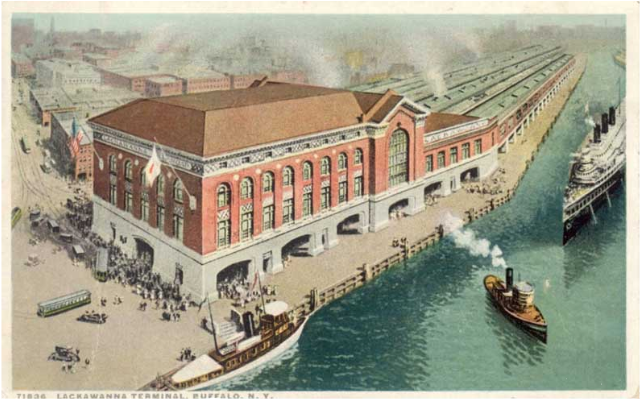History of Buffalo’s DL&W

Industrial innovation at its best
The departure concourse of the former Delaware, Lackawanna & Western (DL&W) terminal remains largely intact on the waterfront in downtown Buffalo, New York.
Built in 1917 by the DL&W Railroad, it served as a major intermodal link, moving anthracite coal from Pennsylvania mines to points north, east, and west and providing luxury passenger service between New York City, Buffalo, and points west. Train passengers could transfer from the terminal to awaiting passenger ships to Great Lakes ports or for further travel West and South via the Nickel Plate Railroad, which also serviced the DL&W terminal.
For decades, the building was central to Buffalo’s movement of people and goods. While the western half of the original complex was demolished in the late twentieth century, the remaining structure, including its pioneering and historic train shed, is not done playing its part in the city’s history.
Cutting-edge form and function
The DL&W terminal was designed by architect Kenneth M. Murchison, best known for his Beaux-Arts public transportation structures. Perhaps the most unique feature of the terminal came from DL&W’s head engineer, Lincoln Bush. His patented design for the train shed, now known as the Bush-style shed, increased passenger comfort and safety. Skylights brightened the platforms, and vents above the tracks funneled out steam and smoke. Large exterior windows introduced plentiful natural light. The DL&W’s elevated double-deck train shed was constructed of reinforced concrete, which was still new to the industry.
While second-story train sheds weren’t unheard of then, they were uncommon. Buffalo’s DL&W double deck train sheds remain a standout. Bush’s modular design allowed for efficient construction, and in Buffalo, the terminal’s location allowed passengers to connect with lake ships and trains in the same place.
Photo by Bruce Jackson
Decline, dormancy, and transformation
Passenger service at the DL&W terminal ended when the Erie and Lackawanna railroads merged in 1963. As highway and air travel grew, passenger rail service declined. In 1979, the grand staircase and Headhouse were demolished by the NFTA in order to facilitate the use of the terminal’s first floor for Buffalo’s then-new Metro Rail project, serving as its head end maintenance facility. Though the original elegance of the train terminal was lost, its structure was preserved.
A foundation for what’s next
Today, the 120,000-square-foot second-story train shed is being returned to public use. The NFTA is constructing a Metro passenger station on the first floor of the structure and providing a direct link to public transportation. It can be said that the new DL&W project is building upon the original purpose and the legacy of Buffalo’s original DL&W terminal. Its scale, location, utility, and ability to connect passengers and visitors have evolved to serve the way we live and gather today.
A storied past and unfolding future
Explore a historic timeline of Buffalo’s DL&W terminal below. Visit the Terminal Bulletin for more historical insight.
Terminal Timeline
-
Savarino DL&W Development LLC partners with Manhattan-based specialists Local Projects and Colicchio Consulting, S.B. Clark Companies of Denver, and Philadelphia’s Eimer Design to conduct extensive feasibility studies, setting the stage for the next chapter in the DL&W terminal’s story.
-
A Multi-Modal Transportation Study assesses how the re-envisioned terminal can best integrate into Buffalo’s evolving transit landscape. Savarino DL&W Development LLC succeeds in having the DL&W terminal placed on the National Register of Historic Places.
-
Savarino partners with Project for Public Spaces to lead community outreach and virtual focus groups, gathering important input from citizens and local stakeholders to perfect plans for the terminal’s redevelopment.
-
Niagara Frontier Transportation Authority (NFTA) repurposes part of the terminal building for Metro Rail repair and storage, designating it the NFTA Depot and Repair Shop. The first-floor offices and tracks have limited use by the NFTA, while the rest of the structure remains dormant.
-
NFTA plans to build a passenger station and street-level entryway on the terminal’s first floor. Following a competitive procurement process, the organization selects an affiliate of Savarino Companies to redevelop the upper level of the historic train shed. Savarino’s plan calls for a mix of public and private uses in the 120,000-square-foot indoor/outdoor space, aligning with NFTA’s goal of reinvigorating the terminal through transit-oriented redevelopment.
-
The Headhouse, which once served passengers with ticketing windows and a waiting area, is demolished to make way for new downtown transportation options. Once a bustling hub, the terminal’s remaining train shed sits largely unused on Buffalo’s waterfront.
-
The DL&W Railroad is absorbed by Conrail along with several other struggling railroads. The DL&W terminal’s role in the city’s broader transportation network fades.Item description
-
As automobile and air travel gains popularity, the use of passenger rail declines. The DL&W sees fewer travelers, and by the 1960s, passenger service comes to an end. When the DL&W merges with the Erie Railroad, the terminal shifts entirely to freight operations and is soon abandoned.
-
Buffalo’s DL&W terminal is a vital link in the region’s transportation network. It supports the city’s industrial boom and connects passengers to other Great Lakes cities and points west.Description text goes here
-
Description text goes hereTo meet growing demand, the railroad expands passenger service from New York City. The DL&W builds a monumental above-grade terminal designed by architect Kenneth M. Murchison in the Beaux-Arts style along the Buffalo waterfront, which the DL&W shares with the Nickel Plate Railroad. The new station consists of two main structures: the Bush Train Shed and the Headhouse. Its massive double-deck train sheds are an innovative use of reinforced concrete, a relatively new material at the time.
-
The Delaware, Lackawanna & Western Railroad (DL&W) incorporates in Pennsylvania. The railroad becomes a primary transporter of cleaner-burning anthracite coal from Northeast Pennsylvania to New York City via New Jersey, fueling industrial growth along the way.Description text goes here



